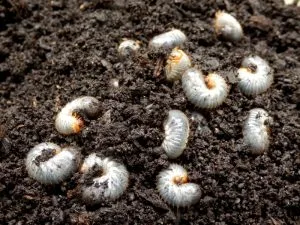Lawn grubs, also known as grub worms, are the larvae of various beetles. Despite their nickname, they are technically not worms at all. Earthworms are good for your yard and garden, while grub worms are definitely an enemy. These plump pests are often whitish in color with brown heads, and their bodies tend to curl into a “C” shape. There are signs of lawn grubs that you can look for in your yard to help you identify an infestation.
Where Do Lawn Grubs Come From?
The answer is beetles. When beetles appear early summer, they begin laying their eggs in grasses and gardens. A few weeks later, these eggs hatch into larvae that burrow down into the soil to find plant or grass roots to eat. By the end of August, your lawn or garden may show signs of grub damage.
Why Lawn Grubs are Bad
When larvae emerge from the egg stage, they do so with huge appetites and your yard becomes an all-you-can eat buffet. You’ll find them dining voraciously on the grass roots of your lawn, but they won’t stop there. Plants, flowers, and veggie gardens also offer tasty roots to feed on.
In order for the grass in your yard to grow green and lush, it needs to be able to absorb nutrients and water through its root system. When too many grubs feed on these roots, the lawn can’t receive the nutrients it requires to survive.
Five Signs of Lawn Grubs in Your Yard
- Wilted stems, droopy leaves, and dead or dying plants can be signs that grubs are attacking your landscaping.
- Irregular yellow or brown patches of grass. Grubs may have been dining on the roots and the grass can’t get the water and nutrients it needs.
- When a lawn has grub damage, it can feel spongy underfoot in the areas where the grubs have been feeding. If you can grab a clump of grass and peel the turf back like a loose rug, it means that the roots have been eaten away or damaged, and you may even see the grubs still trying to finish off the job.
- A sudden appearance of more weeds. When areas of your grass have died off or thinned out, it provides a place for weeds to easily grow and thrive.
- Mole holes. If burrowing creatures like moles and groundhogs are suddenly taking up residence in your yard, or if you are seeing the results of their presence—holes and dug up areas of grass—chances are they’ve found some tasty tidbits, like lawn grubs, to eat. And while you are happy they are eating the grubs, your lawn will be less attractive with the mess they leave in their wake.
To find out more about how to recognize grub damage and how to prevent it, contact us today at 419-529-5296.



Comments (0)
Thanks for your comment!
Thanks for your feedback! Your comments have been successfully submitted! Please note, all comments require admin approval prior to display.
Error submitting comment!
There is a problem with your comment, please see below and try again.